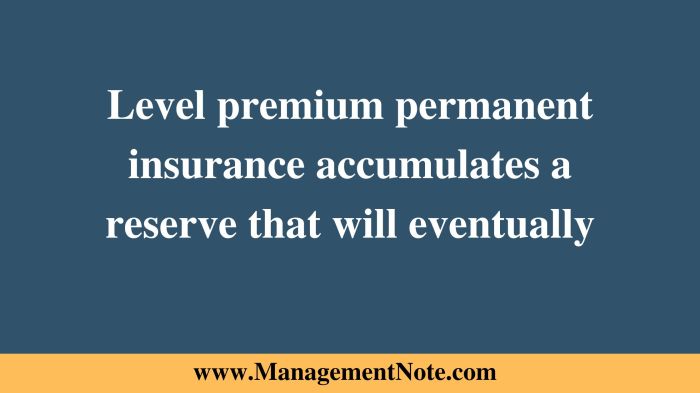Level premium permanent insurance offers a unique financial tool: a steadily growing cash value reserve. Unlike term life insurance, which provides coverage for a specific period, permanent insurance builds a reserve that increases over time, potentially providing a significant financial resource for future needs. Understanding how this reserve accumulates, the factors influencing its growth, and the various ways you can access it is crucial to harnessing its full potential.
This exploration delves into the mechanics of reserve accumulation, the impact of interest rates, and the long-term growth potential. We’ll examine different types of permanent life insurance, outlining their respective reserve accumulation characteristics and illustrating how policy features and external factors influence your financial future.
Reserve as a Source of Funds

Level premium permanent life insurance policies build a cash value reserve over time. This reserve acts as a significant financial resource for the policyholder, accessible under various circumstances and through different methods. Understanding these access methods and their associated tax implications is crucial for effective financial planning.
Accessing the Accumulated Reserve
Policyholders can access their accumulated reserve in several ways, each with its own advantages and disadvantages. The specific options available will depend on the policy’s terms and the insurer’s guidelines. Careful consideration of the tax implications is paramount before making any withdrawals.
Tax Implications of Reserve Access
Withdrawing funds from a life insurance policy’s cash value reserve can have tax consequences. Generally, withdrawals up to the amount of the policy’s cost basis are tax-free. The cost basis represents the premiums paid minus any dividends or other tax-free distributions received. Withdrawals exceeding the cost basis are typically taxed as ordinary income. Loans against the cash value, however, are not considered taxable income until the policy is surrendered or lapses. It is strongly recommended to consult with a qualified tax advisor to understand the specific tax implications related to your individual policy and financial situation. For example, a policyholder with a $100,000 cost basis who withdraws $50,000 will not owe taxes on that withdrawal. However, a withdrawal of $150,000 would result in taxes being owed on the $50,000 exceeding the cost basis.
Procedures for Withdrawing Funds
The process for withdrawing funds typically involves submitting a formal request to the insurance company. This usually requires completing an application form and providing necessary documentation. The insurer will then process the request and transfer the funds to the policyholder’s designated account. Processing times can vary depending on the insurer and the complexity of the withdrawal. Specific instructions and required forms are usually available on the insurer’s website or can be obtained by contacting their customer service department. Delays may occur if additional information or documentation is needed.
Withdrawal Options
Several options exist for accessing the accumulated reserve.
- Partial Withdrawals: These allow the policyholder to withdraw a portion of the cash value without surrendering the policy. This preserves the death benefit and the continued growth of the remaining cash value. However, frequent partial withdrawals may impact the overall growth potential of the reserve.
- Loans: Policyholders can borrow against the cash value. This allows access to funds without surrendering the policy or paying taxes immediately. However, interest accrues on the loan, and if the loan is not repaid, it can reduce the death benefit or even cause the policy to lapse.
- Surrenders: This involves surrendering the entire policy in exchange for the cash value. This is generally a less desirable option unless the policy is no longer needed or the policyholder requires a large sum of money immediately. Taxes may be due on any gains exceeding the cost basis.
Long-Term Growth and Value

Level premium permanent life insurance policies offer a unique investment opportunity through the accumulation of a cash value reserve. This reserve grows over time, offering a potential source of funds for future needs and demonstrating the long-term value proposition of this type of insurance. Understanding the growth potential and comparing it to other investment vehicles is crucial for assessing its suitability within a broader financial strategy.
The reserve within a level premium permanent life insurance policy grows primarily through the investment of premiums after deducting mortality and expense charges. The growth is not guaranteed and depends on the insurer’s investment performance, but it typically offers a degree of stability and tax-advantaged growth. This contrasts with market-dependent investments which can experience significant volatility. The consistent premium payments contribute to the reserve’s steady accumulation, building a substantial amount over the long term. This compounding effect is a key driver of long-term growth.
Reserve Growth Projection
A visual representation of the reserve’s growth might be depicted as a steadily upward-sloping line on a graph. The horizontal axis would represent time (in years), and the vertical axis would represent the cash value of the reserve. The line would start at a low value (initial premium payment) and gradually increase, accelerating its ascent over time due to the compounding effect of interest and additional premium payments. For example, a $100,000 policy might show a reserve value of approximately $150,000 after 10 years, growing to $300,000 after 20 years and potentially reaching $600,000 or more after 30 years, depending on the underlying investment performance and policy type. This is a hypothetical example and actual results will vary. The graph’s slope would not be perfectly linear, reflecting fluctuations in the insurer’s investment returns, but the overall trend would be one of consistent, albeit variable, upward growth.
Reserve as a Source of Funds
The accumulated reserve can serve as a valuable source of funds for various future needs. Policyholders can access a portion of their cash value through policy loans or withdrawals, providing financial flexibility. This can be useful for funding education expenses, retirement needs, or unexpected emergencies. The availability of these funds without impacting the death benefit (depending on the loan terms and policy type) makes it a distinct advantage over other investment vehicles. For instance, a policyholder facing unexpected medical expenses could access funds from their reserve to cover the costs without depleting other savings. Alternatively, the reserve could be used as a supplement to retirement income, providing a stream of funds alongside pensions or other retirement plans.
Reserve Performance Compared to Other Investments
Comparing the long-term performance of a life insurance reserve to other investment options requires careful consideration of several factors, including risk tolerance, tax implications, and the time horizon. While stock market investments might offer higher potential returns, they also carry significantly higher risk. Bonds offer more stability but typically yield lower returns. The life insurance reserve, while not matching the highest potential returns of stocks, offers a balance between growth and security. Its tax-advantaged growth is also a significant advantage, allowing for a greater accumulation of wealth compared to taxable investments. The steady, predictable nature of the reserve’s growth makes it a suitable component of a diversified investment portfolio, providing a stable counterpoint to more volatile investments.
Policy Features and Reserve Accumulation

The accumulation of the reserve in a level premium permanent life insurance policy is a complex process significantly influenced by various policy features and fees. Understanding these factors is crucial for projecting the policy’s long-term value and assessing its suitability for individual financial goals. This section will detail how specific policy elements impact reserve growth.
Policy features such as dividends and riders directly affect reserve accumulation. Dividends, if declared by the issuing company, are typically paid out of the policy’s accumulated surplus and can be used to increase the death benefit, reduce premiums, or purchase paid-up additions, all of which influence the reserve’s growth trajectory. Riders, on the other hand, add extra benefits, such as long-term care or disability income, but often come with associated fees that can reduce the net accumulation of the reserve.
Dividend Impact on Reserve Accumulation
Dividends, when applied to increase the policy’s cash value, directly contribute to a larger reserve. For example, if a policyholder chooses to have dividends applied to increase the death benefit, the overall cash value will grow faster than a policy without dividend payouts. Conversely, if dividends are taken as cash, the reserve will grow more slowly. The impact varies significantly based on the insurer’s dividend allocation policy and the policyholder’s choice of dividend application options. A hypothetical illustration could show a policy with dividends reinvested accumulating 10% more in the reserve over 20 years compared to an identical policy where dividends are withdrawn annually.
Rider Influence on Reserve Accumulation
Adding riders, such as a long-term care rider or a waiver of premium rider, enhances the policy’s benefits but usually involves additional fees. These fees reduce the amount available for reserve accumulation. A policy with multiple riders might show a slower reserve growth compared to a simpler, more basic policy. Consider a policy with a long-term care rider and a waiver of premium rider. The added cost of these features will decrease the net increase in the reserve compared to a policy without these riders, even if the premiums remain the same. The precise impact will depend on the specific rider’s cost structure and the policy’s overall premium.
Impact of Policy Fees on Reserve Accumulation
Various policy fees, including administrative fees, mortality and expense charges, and surrender charges, directly affect the net accumulation of the reserve. These fees are deducted from the premium payments before the funds are used to build the reserve. Higher fees lead to lower reserve accumulation. A policy with high administrative fees will have a smaller reserve compared to a similar policy with lower fees, assuming all other factors remain constant. For instance, a 1% annual administrative fee on a $10,000 premium will result in a $100 reduction in the amount available for reserve growth each year. This difference compounds over time, significantly impacting the overall reserve.
Closing Summary
In conclusion, level premium permanent insurance offers a powerful tool for long-term financial planning. The reserve accumulated provides not only a safety net but also a potential source of funds for future goals, from education expenses to retirement planning. By understanding the factors influencing reserve growth and the various access options available, you can strategically leverage this valuable financial instrument to secure your future. Remember to consult with a qualified financial advisor to determine if permanent life insurance aligns with your individual financial objectives and risk tolerance.
Frequently Asked Questions
What happens to the reserve if I die before accessing it?
The death benefit will be paid to your beneficiaries, which typically includes the accumulated cash value in addition to the face value of the policy.
Can I borrow against my policy’s cash value without affecting the death benefit?
Yes, most permanent life insurance policies allow you to borrow against the cash value. However, interest will accrue on the loan, and if the loan isn’t repaid, it will reduce the death benefit.
Are there any tax implications associated with withdrawing from the cash value?
Withdrawals may be subject to income tax on any gains above the cost basis. Consult a tax professional for specific guidance.
How does the reserve accumulation compare to other investment vehicles?
The growth rate of the reserve is generally less volatile than the stock market but potentially slower than some higher-risk investments. It offers a degree of stability and guarantees, depending on the policy type.